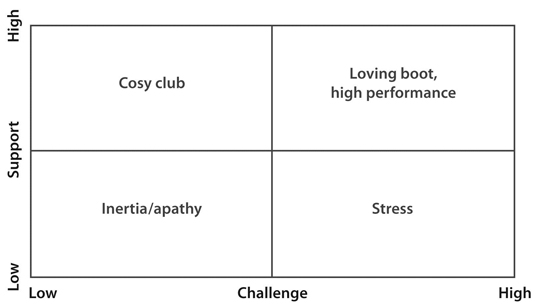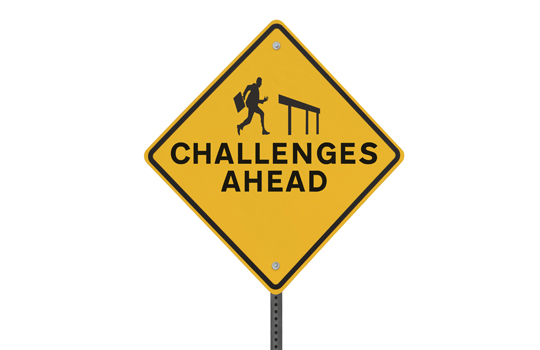Ian Day and John Blakey continue their series on challenging leadership. This time the focus is on conflict.
John Donne wrote the poem 'No Man Is An Island' which represents the truth of our connectedness. This is equally the case for leadership; the quality of relationships is crucial for individual and organisational effectiveness; we have to collaborate to achieve goals. However, conflict sometimes occurs, there can be tension as divisions compete for a limited budget, or if a deadline is missed with knock-on effects, or resulting from the dual responsibilities associated with a matrix structure. In this series of articles on challenging leadership we have emphasised the need to achieve a balance of high support and high challenge as shown in the 2 x 2 matrix below. This is equally important for conflict resolution.

Conflict can be a healthy energy. Studies have shown that teams that are too cohesive and avoid conflict are not as effective as teams that embrace vigorous debate, and air their views energetically. This open debate allows the team to unite around a common goal. As conflict is a constructive force we should not avoid it. But we should recognise that there are times when performance suffers as the tension caused by conflict rises beyond an optimal level. This is when we need to face the conflict and achieve a resolution.
Considering the 2 x 2 support challenge matrix above, there are four styles for handling conflict. In the interim/apathy quadrant the approach to conflict resolution would be to ignore the issue and hope it goes away. In the cosy club of high support and low challenge, conflict resolution is achieved through accommodating the needs of the other person and doing what they require. In the high challenge and low support quadrant a very assertive style would be taken to ensure 'my' concerns are addressed at the expense of others, the downside of this is at an atmosphere of stress pervades. The ideal approach is through high support (concern for others) and high challenge (asserting own needs). This is the area in which high performance is evident as win-win solutions are sought in a collaborative environment of mutual benefit.
Achieving a collaborative balance
So how do we achieve this high support, high challenge collaborative balance, without the stress of unnecessary competition and without avoiding conflict? Here is an example dialogue. David is a financial controller in a matrix organisation with functional accountability to the MD of the manufacturing business unit, and with professional accountability to the chief finance officer of the group. The CFO has said that David needs to attend a seminar on the new international accounting standards. However, the MD has asked David to present a paper to the operating board on proposed cost savings on the same day. Both are equally important and David has a meeting with the FD to resolve this conflicting time pressure.
FD: This seminar has been arranged for weeks and is crucial to our accounting procedures. You must attend.
David: I recognise the importance, however, I am the only person who can present the financial report at the ops board.
FD: This is not good enough; there is a time limit to implement these new accounting standards. You have no choice. You must attend the seminar.
David: I understand your concern about the timescales.
FD: Just make your excuses and say you can't attend the ops board.
David: That's not possible, I'm the only one who knows the numbers and can present the information. But I can't be in two places at once.
FD: We can't risk not implementing the new standards; you have to go to the seminar.
David: There is a way of ensuring both are achieved. Jane can attend the seminar, she is very technically capable and an expert on international accounting standards from her previous role.
FD: But she has only been with us for three months.
David: I understand your concerns; despite being new she used to advise clients on this subject. She may not have the company knowledge, but I have. What I propose is that I attend the ops board, as there is no alternative. Jane goes to the seminar and I've freed my diary for the day after to go through with her the implications and create a detailed plan.
FD: This is risky. I want to ensure no balls are dropped. If anything goes wrong with this your head will be on the block.
David: I fully understand the implications. I have confidence in Jane's ability and this plan will work.
FD: OK, you know where I stand. I want a detailed action plan on my desk by the end of Friday.
David: Good, I'll ensure it will happen.
In this scenario David could have accommodated the over demanding FD and agreed to attend the seminar. Although this would satisfy the demands of the FD, the ops board would be neglected and David would need to explain this to the MD in another tense discussion. Alternatively, David could have compromised, attending half of the seminar and half of the ops board. This is clearly an unsatisfactory solution. Another reaction would be for David to ignore the demands of the FD and hope the situation sorted itself out! Clearly David was not in a position to say 'no way' to the FD. However, David sought to find a collaborative solution. He stood his ground and spoke his truth. As the FD made his demands known, the tension increased. David acknowledged the FD's concerns and entered the zone of uncomfortable debate to achieve an outcome of mutual benefit. There is a risk associated with the solution David proposed, but calculated risks have to be taken to achieve a breakthrough.
As in the previous articles in this series, the balance of support and challenge is crucial. In previous articles we have seen the importance of this when managing performance, setting goals and negotiating. In this article, win-win collaborative solutions are achieved with the presence of both dimensions of support and challenge. The universal application of this approach is a route to leadership effectiveness.
Ian and John's book 'Challenging Coaching– Going beyond traditional coaching to face the FACTS' published by Nicholas Brealey Publishing is available on Amazon. More resources, including a free chapter download can be accessed via www.challengingcoaching.co.uk. This is part of a monthly column on TrainingZone which explores the detail of challenging leadership.









